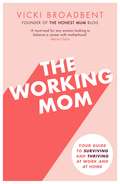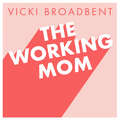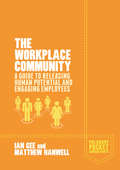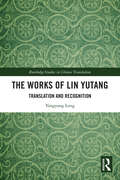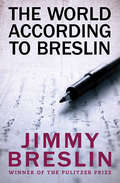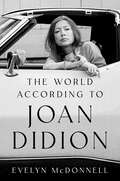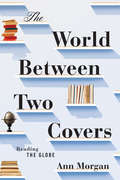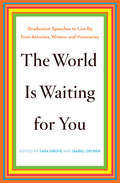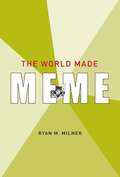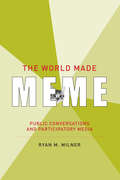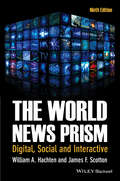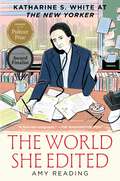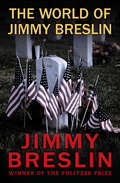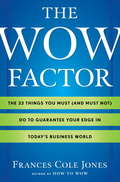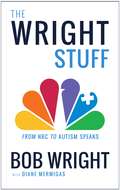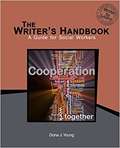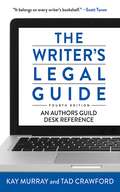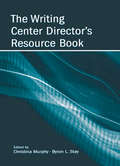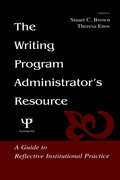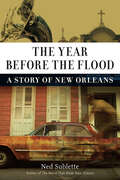- Table View
- List View
The Working Mom: The Honest Mum's Guide to Surviving and Thriving at Work and at Home
by Vicki BroadbentChosen by the Independent as one of the 10 best business books written by women'Vicki is one inspirational mumboss, who shares her secrets to juggling a thriving business with raising a family in this entertaining and empowering read!' Una Healy'Ideal for going back to work without losing your mind . . . a no-nonsense guide to navigating the transition' Marie Claire 'If ever there is a person who has shown just how successful you can be online whilst also being an amazing parent it is Vicki. Read, learn and follow. A brilliant book from an inspirational mother'. Natasha Courtenay-Smith, author of The Million Dollar BlogIn The Working Mom, Vicki Psarias, founder of HonestMum.com, shares her manifesto for surviving and thriving at work and at home. Vicki writes about everything from juggling work and family, to regaining your confidence after having a baby and battling imposter syndrome.An award-winning blogger and vlogger, in this book Vicki shares how to turn your passions into a business that suits the modern mum's lifestyle. The Working Mom is full of practical advice, tips and tricks to help fellow #mumbosses build their own business or return to work, while creating a personal brand and learning how to market yourself.Vicki's funny, fresh approach to life and work as a mum has brought her a loyal fanbase and a brilliantly successful business: her blog Honest Mum is one of the UK's most popular parenting and lifestyle sites, and the blog combined with Vicki's social channels has an average monthly reach of 1 million. A Lean In for the blogging and vlogging generation, The Working Mom is an essential book for all parents, whether they are returning to work or looking to start a new career, as well as anyone looking to build their brand or business online.'A must-read for the modern Mum; particularly one who has aspirations to build her own business. I wish I had been able to read it three years ago!' Katie Massie-Taylor, Co-Founder, Mush
The Working Mom: The Honest Mum's Guide to Surviving and Thriving at Work and at Home
by Vicki BroadbentChosen by the Independent as one of the 10 best business books written by women'Vicki is one inspirational mumboss, who shares her secrets to juggling a thriving business with raising a family in this entertaining and empowering read!' Una Healy'Ideal for going back to work without losing your mind . . . a no-nonsense guide to navigating the transition' Marie Claire'If ever there is a person who has shown just how successful you can be online whilst also being an amazing parent it is Vicki. Read, learn and follow. A brilliant book from an inspirational mother'. Natasha Courtenay-Smith, author of The Million Dollar BlogIn The Working Mom, Vicki Psarias, founder of HonestMum.com, shares her manifesto for surviving and thriving at work and at home. Vicki writes about everything from juggling work and family, to regaining your confidence after having a baby and battling imposter syndrome.An award-winning blogger and vlogger, in this book Vicki shares how to turn your passions into a business that suits the modern mum's lifestyle. The Working Mom is full of practical advice, tips and tricks to help fellow #mumbosses build their own business or return to work, while creating a personal brand and learning how to market yourself.Vicki's funny, fresh approach to life and work as a mum has brought her a loyal fanbase and a brilliantly successful business: her blog Honest Mum is one of the UK's most popular parenting and lifestyle sites, and the blog combined with Vicki's social channels has an average monthly reach of 1 million. A Lean In for the blogging and vlogging generation, The Working Mom is an essential book for all parents, whether they are returning to work or looking to start a new career, as well as anyone looking to build their brand or business online.'A must-read for the modern Mum; particularly one who has aspirations to build her own business. I wish I had been able to read it three years ago!' Katie Massie-Taylor, Co-Founder, Mush
The Working Mom: The Honest Mum's Guide to Surviving and Thriving at Work and at Home
by Vicki BroadbentChosen by the Independent as one of the 10 best business books written by women'Vicki is one inspirational mumboss, who shares her secrets to juggling a thriving business with raising a family in this entertaining and empowering read!' Una Healy'Ideal for going back to work without losing your mind . . . a no-nonsense guide to navigating the transition' Marie Claire 'If ever there is a person who has shown just how successful you can be online whilst also being an amazing parent it is Vicki. Read, learn and follow. A brilliant book from an inspirational mother'. Natasha Courtenay-Smith, author of The Million Dollar BlogIn The Working Mom, Vicki Psarias, founder of HonestMum.com, shares her manifesto for surviving and thriving at work and at home. Vicki writes about everything from juggling work and family, to regaining your confidence after having a baby and battling imposter syndrome.An award-winning blogger and vlogger, in this book Vicki shares how to turn your passions into a business that suits the modern mum's lifestyle. The Working Mom is full of practical advice, tips and tricks to help fellow #mumbosses build their own business or return to work, while creating a personal brand and learning how to market yourself.Vicki's funny, fresh approach to life and work as a mum has brought her a loyal fanbase and a brilliantly successful business: her blog Honest Mum is one of the UK's most popular parenting and lifestyle sites, and the blog combined with Vicki's social channels has an average monthly reach of 1 million. A Lean In for the blogging and vlogging generation, The Working Mom is an essential book for all parents, whether they are returning to work or looking to start a new career, as well as anyone looking to build their brand or business online.'A must-read for the modern Mum; particularly one who has aspirations to build her own business. I wish I had been able to read it three years ago!' Katie Massie-Taylor, Co-Founder, Mush
The Workplace Community
by Ian GeeThe Workplace Community offers a structured, practical guide to developing collaborative knowledge-based communities in the workplace, from introducing employees and managers to new ways of working, to measuring effectiveness and providing corrective interventions for those who haven't achieved the desired results.
The Works of Lin Yutang: Translation and Recognition (Routledge Studies in Chinese Translation)
by Yangyang LongThe Works of Lin Yutang is the first book to provide a comprehensive study of Lin Yutang’s translation theory and translated (and written) works in English as a whole, examined from the perspective of his pursuit of recognition of cultural equity between China and the English-speaking world. The arc of the book is Lin’s new method of translating China to the Anglophone world, which is crucial to rendering Chinese culture as an equal member of the modern world. This book identifies Lin’s legacy of translation and recognition as his acknowledgement of source and target cultural territories in translation, and at the same time, his questioning of perspectives that privilege the authority of either. This book will appeal to scholars and students in Translation Studies, World and Comparative Literature, Literary and Cultural Studies, and Chinese Studies. It can also be used as a reference work for practitioners in translation and creative writing.
The World According to Breslin: How The Good Guys Finally Won, The World According To Breslin, And The World Of Jimmy Breslin
by Jimmy BreslinClassic columns from the legendary New York journalist—&“a master of the tough-talking, thoroughly researched, contentious, street-wise vignette&” (San Francisco Chronicle). Although his career spans decades, the seven years that Jimmy Breslin spent at the New YorkDaily News sparked some of his finest work. When New York City tumbled into economic and social chaos at the end of the 1970s, Breslin was there. In his brief, insightful columns, he looked at the city not from the top down but from the bottom up. Eschewing the view of politicians, socialites, and captains of industry, Breslin&’s heroes are men like Jim Moran, the cop who drove John Lennon to the emergency room after he was shot, or Barney Baker, an ex-boxer who served as bodyguard to mobster Meyer Lansky. These are average people who see big things, and Breslin is their herald. This ebook features an illustrated biography of Jimmy Breslin including rare photos and never-before-seen documents from the author&’s personal collection.
The World According to Joan Didion
by Evelyn McDonnell**INDIE BESTSELLER**A MOST ANTICIPATED BOOK OF 2023 by The Millions • B&N Best Books of 2023 • “Shaped by intellectual rigor and artistic grace … McDonnell’s portrait is vibrant, fluent, sensitive, and clarifying.” — Booklist, starred reviewAn intimate exploration of the life, craft, and legacy of one of the most revered and influential writers, an artist who continues to inspire fans and creatives to cultivate practices of deep attention, rigorous interrogation and beautiful style.Joan Didion was a writer’s writer; not only a groundbreaking journalist, essayist, novelist and screenwriter, but a keen observer who honed her sights on life’s telling details. Her insights continue to influence creatives and admirers, encouraging them to become close observers of the world, unsentimental critics, and meticulous stylists.An antidote to a global view that narrows our vision to the smallest screens, The World According To Joan Didion is a meditation on the people, places, and objects that propelled Didion’s prose and an invitation to journalists, storytellers, and life adventurers to “throw themselves into the convulsions of the world,” as she once said.Evelyn McDonnell, the acclaimed journalist, essayist, critic, feminist, native Californian, and university professor who regularly teaches Didion’s work, is attuned to interpret Didion’s vision for readers today. Inspired by Didion’s own words—from her works both published and unpublished—and informed by the people who knew Didion and those whose lives she shaped, The World According to Joan Didion is an illustrated journey through her life, tracing the path she carved from Sacramento, Portuguese Bend, Los Angeles, and Malibu to Manhattan, Miami, and Hawaii. McDonnell reveals the world as it was seen through Didion’s eyes and explores her work in chapters keyed to the singular physical motifs of her writing: Snake. Typewriter. Hotel. Notebook. Girl. Etc.One of the first books to be published after the revered writer’s death in 2021, The World According to Joan Didion is a literary companion for those embarking on new journeys and a guide to innovative ways of being. It will radically transform the way you explore the world, and will help you answer the question as you sit in a café, or on a plane or train, pondering the future: What would Joan Didion have seen?The World According to Joan Didion includes 19 black-and-white illustrations and photos throughout.
The World Between Two Covers: Reading the Globe
by Ann MorganA beguiling exploration of the joys of reading across boundaries, inspired by the author's year-long journey through a book from every country. Ann Morgan writes in the opening of this delightful book, "I glanced up at my bookshelves, the proud record of more than twenty years of reading, and found a host of English and North American greats starting down at me...I had barely touched a work by a foreign language author in years...The awful truth dawned. I was a literary xenophobe." Prompted to read a book translated into English from each of the world's 195 UN-recognized countries (plus Taiwan and one extra), Ann sought out classics, folktales, current favorites and commercial triumphs, novels, short stories, memoirs, and countless mixtures of all these things. The world between two covers, the world to which Ann introduces us with affection and no small measure of wit, is a world rich in the kind of narratives that engage us passionately: we meet an irreverent junk food-obsessed heroine in Kuwait, an explorer from Togo who spent years among the Inuit in Greenland, and a former child circus performer of Roma background seeking sanctuary in Switzerland. Ann's quest explores issues that affect us all: personal, political, national, and global. What is cultural heritage? How do we define national identity? Is it possible to overcome censorship and propaganda? And, above all, why and how should we read from other cultures, languages, and traditions? Illuminating and inspiring, The World Between Two Covers welcomes us into the global community of stories.
The World Is Waiting for You: Graduation Speeches to Live By from Activists, Writers, and Visionaries
by Edited by Tara Grove and Isabel OstrerInspiring commencement speeches from Wynton Marsalis, Toni Morrison, Gloria Steinem, and others: &“The perfect gift for grads-to-be&” (O, The Oprah Magazine). &“The voices of conformity speak so loudly. Don&’t listen to them,&” acclaimed author and award-winning journalist Anna Quindlen cautioned graduates of Grinnell College. Jazz virtuoso and educator Wynton Marsalis advised new Connecticut College alums not to worry about being on time, but rather to be in time—because &“time is actually your friend. He don&’t come back because he never goes away.&” And renowned physician and humanitarian Paul Farmer revealed at the University of Delaware his remarkable discovery—the new disease Empathy Deficit Disorder—and assured the commencers it could be cured. The prescient, fiery feminism of Gloria Steinem sits parallel to that of celebrated writer Ursula K. Le Guin, who asks, &“What if I talked like a woman right here in public?&” Nobel Prize–winning author Toni Morrison sagaciously ponders how people centuries from now will perceive our current times, and Pulitzer Prize–winning author Barbara Kingsolver asks those born into the Age of Irony to &“imagine getting caught with your Optimism hanging out&” and implores us always to act and speak the truth. With eighteen rousing graduation speeches, The World Is Waiting for You speaks to anyone who might take to heart the advice of Planned Parenthood president Cecile Richards—&“life as an activist, troublemaker, or agitator is a tremendous option and one I highly recommend&”—and is the perfect gift for all who are ready to move their tassels to the left.
The World Made Meme: Public Conversations and Participatory Media
by Ryan M. MilnerInternet memes -- digital snippets that can make a joke, make a point, or make a connection -- are now a lingua franca of online life. They are collectively created, circulated, and transformed by countless users across vast networks. Most of us have seen the cat playing the piano, Kanye interrupting, Kanye interrupting the cat playing the piano. In The World Made Meme, Ryan Milner argues that memes, and the memetic process, are shaping public conversation. It's hard to imagine a major pop cultural or political moment that doesn't generate a constellation of memetic texts. Memetic media, Milner writes, offer participation by reappropriation, balancing the familiar and the foreign as new iterations intertwine with established ideas. New commentary is crafted by the mediated circulation and transformation of old ideas. Through memetic media, small strands weave together big conversations. Milner considers the formal and social dimensions of memetic media, and outlines five basic logics that structure them: multimodality, reappropriation, resonance, collectivism, and spread. He examines how memetic media both empower and exclude during public conversations, exploring the potential for public voice despite everyday antagonisms. Milner argues that memetic media enable the participation of many voices even in the midst of persistent inequality. This new kind of participatory conversation, he contends, complicates the traditional culture industries. When age-old gatekeepers intertwine with new ways of sharing information, the relationship between collective participation and individual expression becomes ambivalent. For better or worse -- and Milner offers examples of both -- memetic media have changed the nature of public conversations.
The World Made Meme: Public Conversations and Participatory Media (The Information Society Series)
by Ryan M. MilnerHow memetic media—aggregate texts that are collectively created, circulated, and transformed—become a part of public conversations that shape broader cultural debates.Internet memes—digital snippets that can make a joke, make a point, or make a connection—are now a lingua franca of online life. They are collectively created, circulated, and transformed by countless users across vast networks. Most of us have seen the cat playing the piano, Kanye interrupting, Kanye interrupting the cat playing the piano. In The World Made Meme, Ryan Milner argues that memes, and the memetic process, are shaping public conversation. It's hard to imagine a major pop cultural or political moment that doesn't generate a constellation of memetic texts. Memetic media, Milner writes, offer participation by reappropriation, balancing the familiar and the foreign as new iterations intertwine with established ideas. New commentary is crafted by the mediated circulation and transformation of old ideas. Through memetic media, small strands weave together big conversations. Milner considers the formal and social dimensions of memetic media, and outlines five basic logics that structure them: multimodality, reappropriation, resonance, collectivism, and spread. He examines how memetic media both empower and exclude during public conversations, exploring the potential for public voice despite everyday antagonisms. Milner argues that memetic media enable the participation of many voices even in the midst of persistent inequality. This new kind of participatory conversation, he contends, complicates the traditional culture industries. When age-old gatekeepers intertwine with new ways of sharing information, the relationship between collective participation and individual expression becomes ambivalent. For better or worse—and Milner offers examples of both—memetic media have changed the nature of public conversations.
The World News Prism: Digital, Social and Interactive
by William A. Hachten James F. ScottonNow available in a fully revised and updated ninth edition, World News Prism provides in-depth analysis of the changing role of transnational news media in the 21st-century. Includes three new chapters on Russia, Brazil, and India and a revised chapter on the Middle East written by regional media experts Features comprehensive coverage of the growing impact of social media on how news is being reported and received Charts the media revolutions occurring throughout the world and examines their effects both locally and globally Surveys the latest developments in new media and forecasts future developments
The World She Edited: Katharine S. White at The New Yorker
by Amy ReadingA lively and intimate biography of trailblazing and era-defining New Yorker editor Katharine S. White, who helped build the magazine’s prestigious legacy and transform the 20th century literary landscape for women.In the summer of 1925, Katharine Sergeant Angell White walked into The New Yorker’s midtown office and left with a job as an editor. The magazine was only a few months old. Over the next thirty-six years, White would transform the publication into a literary powerhouse.This exquisite biography brings to life the remarkable relationships White fostered with her writers and how these relationships nurtured an astonishing array of literary talent. She edited a young John Updike, to whom she sent seventeen rejections before a single acceptance, as well as Vladimir Nabokov, with whom she fought incessantly, urging that he drop needlessly obscure, confusing words. White’s biggest contribution, however, was her cultivation of women writers whose careers were made at The New Yorker—Janet Flanner, Mary McCarthy, Elizabeth Bishop, Jean Stafford, Nadine Gordimer, Elizabeth Taylor, Emily Hahn, Kay Boyle, and more. She cleared their mental and financial obstacles, introduced them to each other, and helped them create now classic stories and essays. She propelled these women to great literary heights and, in the process, reinvented the role of the editor, transforming the relationship to be not just a way to improve a writer’s work but also their life.Based on years of scrupulous research, acclaimed author Amy Reading creates a rare and deeply intimate portrait of a prolific editor—through both her incredible tenure at The New Yorker, and her famous marriage to E.B. White—and reveals how she transformed our understanding of literary culture and community.
The World of Jimmy Breslin: World Without End, Amen; The Gang That Couldn't Shoot Straight; Table Money; And Forsaking All Others
by Jimmy BreslinThe Pulitzer Prize–winning journalist&’s early columns &“peopled by some of the funniest, looniest and saddest characters anywhere outside of a zoo&” (The New York Times). In the 1960s, as the once-proud New York Herald Tribune spiraled into bankruptcy, the brightest light in its pages was an ebullient young columnist named Jimmy Breslin. While ordinary columnists wrote about politics, culture, or the economy, Breslin&’s chief topics were the city and Breslin himself. He was chummy with cops, arsonists, and thieves, and told their stories with grace, wit, and lightning-quick prose. Whether covering the five boroughs, Vietnam, or the death of John F. Kennedy, Breslin managed to find great characters wherever he went. This collection includes some of Breslin&’s most famous early writing. Here are the unforgettable New Yorkers Sam Silverware and Larry Lightfingers, the celebrated interview with President Kennedy&’s gravedigger, and the classic &“People I&’m Not Talking To Next Year.&” But the most important voice here is Breslin&’s—as vibrant as ever. This ebook features an illustrated biography of Jimmy Breslin including rare photos and never-before-seen documents from the author&’s personal collection.
The Wow Factor: The 33 Things You Must (and Must Not) Do to Guarantee Your Edge in Today's Business World
by Frances Cole JonesIn today's business world, people need solutions, skills, and confidence to land the perfect job or keep an existing one. "The Wow Factor" offers 33 things individuals can do to ensure they rise to the top, no matter the circumstance.
The Wright Stuff: From NBC to Autism Speaks
by Bob Wright Diane MermigasThe former CEO of NBC &“reflects on his years at the pinnacle of network television, and also on the Wrights&’ work as co-founders of Autism Speaks&” (Palm Beach Daily News). Named president and CEO of NBC at the age of 43, he faced a two-headed dragon: on one hand, distrust from the network people deeply skeptical of the &“suit&” from GE, their new corporate parent; and on the other, fiscal oversight demands from a cautious, conservative institution reluctant to invest heavily in a media business they didn&’t understand. For the next 20 years, he managed to navigate the fine line between the two and in the process completely reinvent—and save—the network. His name is Bob Wright. Under his leadership, a traditional network, struggling to survive a changing landscape, was transformed into a $45 billion cable and internet giant. What does someone like that do when he retires? If he&’s Bob Wright, he starts all over again. At almost the exact same time as Bob&’s NBC reign was winding down, his grandson Christian was diagnosed with autism, a condition then poorly understood. Baffled by a lack of medical knowledge and community support, Bob and his wife Suzanne founded Autism Speaks, which in short order became the leading advocacy and research funding organization for this mysterious condition that so devastates families. As the two story lines unfold in The Wright Stuff, readers will gradually see that both endeavors—revitalizing NBC and building Autism Speaks—reflect the same key management tenets that apply to any organization facing disruptive change. A portion of the proceeds from this book will be donated to advance autism research.
The Writer's Handbook: A Guide For Social Workers
by Dona Young Andrea Tamburro Marshelia HarrisThe Writer's Handbook: A Guide for Social Workers is a writing reference for social work majors and graduate students. Specific to social work, the text contains chapters on documenting in the field, research, and APA style citation and formatting. In addition, learners have access to full chapters on principles of grammar (such as verbs, pronouns, and parallel structure), punctuation (commas, semicolons, colons, quotation marks, and so on), and writing style (active voice, conciseness).The text is designed to help writers at all levels bring the quality of their work to higher levels by reviewing principles followed by practice.Since APA style is required for social work study, a special effort has been make to present a full chapter on APA style as well as integrate APA requirements in formatting and style throughout the text.The text is reader friendly, contains keys to all exercises at the back of the book, and gives learners access to interactive activities at the book's website.
The Writer's Legal Guide, Fourth Edition: An Authors Guild Desk Reference
by Tad Crawford Kay MurrayIn an increasingly digitized and complex publishing world, writers need to know how to protect themselves against copyright infringement, legal trouble, and unwise concessions to publishers. Still the author's foremost advocate for copyright protection, fair contracts, and free expression, the Authors Guild has once again partnered with Allworth Press to update this invaluable reference. Thoroughly revised to reflect the many changes in the publishing industry, the fourth edition offers plain-English explanations of legal and business aspects of the trade, from electronic rights and ebooks to contracts and accounting. Other topics include: Registering copyrights, including onlineTaxes and bookkeepingFollowing fair use guidelinesNegotiating contracts with publishers and agentsObtaining permissions to use others' workDealing with periodical, syndication, film, television, play, and audio rights agreementsHandling business disputesUnderstanding libel, privacy, and the limits of free expressionAvoiding self-publishing misstepsPlanning authors' estates
The Writing Center Director's Resource Book
by Christina Murphy Byron L. StayThe Writing Center Director's Resource Book has been developed to serve as a guide to writing center professionals in carrying out their various roles, duties, and responsibilities. It is a resource for those whose jobs not only encompass a wide range of tasks but also require a broad knowledge of multiple issues.The volume provides information on the most significant areas of writing center work that writing center professionals--both new and seasoned--are likely to encounter. It is structured for use in diverse institutional settings, providing both current knowledge as well as case studies of specific settings that represent the types of challenges and possible outcomes writing center professionals may experience. This blend of theory with actual practice provides a multi-dimensional view of writing center work.In the end, this book serves not only as a resource but also as a guide to future directions for the writing center, which will continue to evolve in response to a myriad of new challenges that will lie ahead.
The Writing Program Administrator's Resource: A Guide To Reflective Institutional Practice
by Stuart C. Brown Theresa Enos Catherine ChaputThe role of the writing program administrator is one of diverse activities and challenges, and preparation for the position has traditionally come through performing the job itself. As a result, uninitiated WPAs often find themselves struggling to manage the various requirements and demands of the position, and even experienced WPAs often encounter situations on which they need advice. The Writing Program Administrator's Resource has been developed to address the needs of all WPAs, regardless of background or experience. It provides practical, applicable tools to effectively address the differing and sometimes competing roles in which WPAs find themselves. Readers will find an invaluable collection of articles in this volume, addressing fundamental practices and issues encountered by WPAs in their workplace settings and focusing on the hows and whys of writing program administration. With formal preparation and training only now beginning to catch up to the very real needs of the WPA, this volume offers guidance and support from authoritative and experienced sources--educators who have established the definitions and standards of the position; who have run into obstacles and surmounted them; and who have not just survived but thrived in their roles as WPAs. Editors Stuart C. Brown and Theresa Enos contribute their own experience and bring together the voices of their colleagues to delineate the intellectual scope and practices of writing program administration as an emerging discipline. Established and esteemed leaders in the field offer insights, advice, and plans of action for the myriad scenarios encountered in the position, encouraging WPAs and helping them to realize that they often know more than they think they do. This resource is required reading for the new WPA, and an essential reference for all who serve in the WPA role. As a guidebook for WPAs, it is destined to become a fixture on the desk of every educator involved with or interested in administrating writing programs, writing centers, and writing-across-the-curriculum efforts.
The Year Before the Flood: A Story of New Orleans
by Ned SubletteWith a style the Los Angeles Times calls as "vivid and fast-moving as the music he loves," Ned Sublette's powerful new book drives the reader through the potholed, sinking streets of the United States's least-typical city.In this eagerly awaited follow-up to The World That Made New Orleans, Sublette's award-winning history of the Crescent City's colonial years, he traces an arc of his own experience, from the white supremacy of segregated 1950s Louisiana through the funky year of 2004–2005--the last year New Orleans was whole. By turns irreverent, joyous, darkly comic, passionate, and polemical, The Year Before the Flood juxtaposes the city's crowded calendar of parties, festivals, and parades with the murderousness of its poverty and its legacy of racism. Along the way, Sublette opens up windows of American history that illuminate the present: the trajectory of Mardi Gras from pre–Civil War days, the falsification of Southern history in movies, the city's importance to early rock and roll, the complicated story of its housing projects, the uniqueness of its hip-hop scene, and the celebratory magnificence of the participatory parades known as second lines. With a grand, unforgettable cast of musicians and barkeeps, scholars and thugs, vibrating with the sheer excitement of New Orleans, The Year Before the Flood is an affirmation of the power of the city's culture and a heartbreaking tale of loss that definitively establishes Ned Sublette as a great American writer for the 21st century.
The Year That Defined American Journalism: 1897 and the Clash of Paradigms
by W. Joseph CampbellThe Year that Defined American Journalism explores the succession of remarkable and decisive moments in American journalism during 1897 – a year of significant transition that helped redefine the profession and shape its modern contours. This defining year featured a momentous clash of paradigms pitting the activism of William Randolph Hearst's participatory 'journalism of action' against the detached, fact-based antithesis of activist journalism, as represented by Adolph Ochs of the New York Times, and an eccentric experiment in literary journalism pursued by Lincoln Steffens at the New York Commercial-Advertiser. Resolution of the three-sided clash of paradigms would take years and result ultimately in the ascendancy of the Times' counter-activist model, which remains the defining standard for mainstream American journalism. The Year That Defined American Journalism introduces the year-study methodology to mass communications research and enriches our understanding of a pivotal moment in media history.
The Year Time Stopped: The Global Pandemic In Photos
by Christina Hawatmeh Nour ChamounCurated by the founders of Scopio, a community-based image marketplace, a stunning and unforgettable visual history that captures the world’s response to major events that defined 2020: the COVID pandemic and the sweeping movements for racial and social justice.In 2020, the world experienced massive change. Millions of lives were ended—and millions more upended—by the Covid-19 pandemic. The shocking police killings of Black men and women gave rise to powerful social movements and widespread collective action to rectify centuries of injustice and racism in the United States and globally. Together, these three colossal events tested the resilience of the social fabric bringing us all together. Attempting to illuminate and make sense of this new reality, photographers from around the world documented these transformational moments as they unfolded. Carefully combing through their archive, the founders of Scopio have curated these photographs to tell the story of the year 2020. It began with a collective sense of isolation and fear to eventually people coming together and protesting the social injustices that were uncovered later that year.Representing artists from around the globe, The Year Time Stopped seeks to empower us and give credence to the extraordinary circumstances that changed our world. The 200 images in this striking visual collection are indelible, impassioned, and unforgettable. Taken together, they are a singular testament to this unprecedented time.
The Year of My Life, Second Edition: A Translation of Issa's Oraga Haru
by Issa KobayashiThis title is part of UC Press's Voices Revived program, which commemorates University of California Press’s mission to seek out and cultivate the brightest minds and give them voice, reach, and impact. Drawing on a backlist dating to 1893, Voices Revived makes high-quality, peer-reviewed scholarship accessible once again using print-on-demand technology. This title was originally published in 1960.
The Year of Reading Dangerously: How Fifty Great Books (and Two Not-So-Great Ones) Saved My Life
by Andy Miller“[A] fanciful, endearing account of his experiences tackling classic works of fiction. . . . There is plenty of hilarity in [this] intimate literary memoir.” —Publishers WeeklyNearing his fortieth birthday, author and critic Andy Miller realized he’s not nearly as well read as he’d like to be. A devout book lover who somehow fell out of the habit of reading, he began to ponder the power of books to change an individual life—including his own—and to the define the sort of person he would like to be. Beginning with a copy of Bulgakov’s Master and Margarita, he embarks on a literary odyssey of mindful reading and wry introspection. From Middlemarch to Anna Karenina to A Confederacy of Dunces, these are books Miller felt he should read; books he’d always wanted to read; books he’d previously started but hadn’t finished; and books he’d lied about having read to impress people.Combining memoir and literary criticism, The Year of Reading Dangerously is Miller’s heartfelt, humorous examination of what it means to be a reader. Passionately believing that books deserve to be read, enjoyed, and debated in the real world, Miller documents his reading experiences and how they resonated in his daily life and ultimately his very sense of self. The result is a witty and insightful journey of discovery and soul-searching that celebrates the abiding miracle of the power of reading.“An affecting tale of the rediscovery of great books . . . [by] a friendly, funny Brit.” —Boston Globe“Funny and engaging.” —Kirkus Reviews“Amiable, circumstantial, amusing, charming. . . . [Miller’s] style owes something . . . to Joe Brainard and David Foster Wallace.” —The Times (London)
